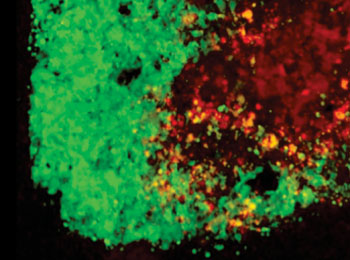Stem Cells Loaded with Oncolytic Herpes Virus Destroy Brain Tumors in Mouse Model
By LabMedica International staff writers
Posted on 27 May 2014
Cancer researchers treated mouse models of the human brain tumor glioblastoma multiforme by injecting the animals with stem cells loaded with oncolytic herpes virus and treated virus-resistant tumors with oncolytic herpes viruses genetically engineered to express the proapoptotic cytokine TRAIL.Posted on 27 May 2014
Glioblastoma multiforme (GBM) is an aggressive brain tumor, fatal within one year from diagnosis in most patients despite intensive treatment with surgery, radiation, and chemotherapy. The migratory and microscopically invasive nature of GBM as well as its resistance to chemotherapy renders conventional therapies inadequate in its treatment. Attempts to treat GMB with oncolytic viruses have been unsuccessful mainly because of insufficient viral spread after tumor resection.

Image: Stem cells loaded with cancer-killing herpes virus attack a brain tumor cell. Tumor cells in green. oHSV-loaded stem cells in red. oHSV-infected tumor cells in yellow (Photo courtesy of Dr. Khalid Shah, Harvard University).
Investigators at Harvard University (Cambridge, MA, USA) loaded human mesenchymal stem cells (MSC) with oncolytic herpes simplex virus (MSC-oHSV), and the fate of the stem cells following injection into mice was followed by real-time imaging in vitro and in vivo. The efficacy of MSC-oHSV and its proapoptotic variant, oHSV-TRAIL (tumor necrosis factor-related apoptosis-inducing ligand) encapsulated in synthetic extracellular matrix (sECM), was tested in different mouse GBM models, which more accurately reflected the current clinical settings of malignant, resistant, and resected tumors.
TRAIL is a cytokine that is produced and secreted by most normal tissue cells. It causes apoptosis primarily in tumor cells by binding to certain death receptors. Since the mid-1990s it has been used as the basis for several anticancer drugs, but was not been found to have any significant survival benefit.
Results published in the June 2014 online edition of the Journal of the [US] National Cancer Institute revealed that the MSC-oHSVs effectively produced oHSV progeny, which resulted in killing of GBMs in vitro and in vivo mediated by a dynamic process of oHSV infection and tumor destruction. sECM-encapsulated MSC-oHSVs resulted in statistically significant increased anti-GBM efficacy compared with direct injection of purified oHSV in a preclinical model of GBM resection, resulting in prolonged median survival of the mice. In a model of virus resistant tumors, it was seen that MSCs loaded with oHSV-TRAIL effectively induced apoptosis-mediated killing and prolonged median survival of the mice.
“Our approach can overcome problems associated with current clinical procedures,” said senior author Dr. Khalid Shah, professor of medicine at Harvard University. “The work will have direct implications for designing clinical trials using oncolytic viruses, not only for brain tumors, but for other solid tumors. We know that 70%–75% of glioblastoma patients undergo surgery for tumor debulking, and we have previously shown that MSCs encapsulated in biocompatible gels can be used as therapeutic agents in a mouse model that mimics this debulking. So, we loaded MSCs with oncolytic herpes virus and encapsulated these cells in biocompatible gels and applied the gels directly onto the adjacent tissue after debulking. We then compared the efficacy of virus-loaded, encapsulated MSCs versus direct injection of the virus into the cavity of the debulked tumors. They survived because the virus does not get washed out by the cerebrospinal fluid that fills the cavity. Previous studies that have injected the virus directly into the resection cavity did not follow the fate of the virus in the cavity. However, our imaging and side-by-side comparison studies showed that the naked virus rarely infects the residual tumor cells. This could give us insight into why the results from clinical trials with oncolytic viruses alone were modest.”
Related Links:
Harvard University













